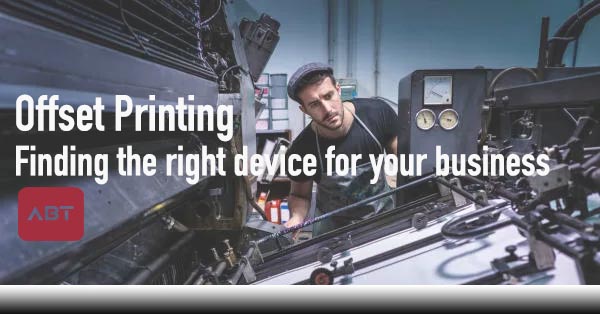Offset Printing | What your business needs to know
Offset printing, also known as offset lithography, is a technique commonly used for producing high-quality printed materials like newspapers, magazines, brochures, posters, and packaging. You might find it interesting because it’s versatile and efficient for producing large quantities of printed items.
Here’s how offset printing works:
- Image Preparation: You start by creating a printing plate for each color used in your design. These plates are typically made of metal or polyester and have the image or text you want to print chemically etched onto them. Each plate corresponds to one color in your final print, like cyan, magenta, yellow, and black (CMYK) for full-color printing.
- Ink and Water Separation: Offset printing relies on the fact that oil-based ink and water don’t mix. On the printing press, there are rollers for ink and water. Your printing plates have areas that either attract ink or water. Ink is applied to the image areas on the plate, while non-image areas are kept damp with water. This setup ensures that ink adheres only to the image areas.
- Transfer to Blanket Cylinder: After separating ink and water on the plate, the image is transferred to a rubber blanket cylinder. The rubber blanket prevents the image from being directly applied to the paper, maintaining consistent and even pressure during printing.
- Transfer to Paper: Your paper is fed through the press and meets the blanket cylinder, where the inked image is transferred from the blanket to the paper. The paper absorbs the ink, resulting in your printed image.
- Drying: In the final stage, the printed sheets go through drying units or racks to remove any remaining moisture and set the ink. This step is crucial to prevent smudging and ensure your printed material is ready for finishing and distribution.
Offset printing has some advantages for you:
- It produces high-quality output with sharp and precise image reproduction.
- You can rely on consistency in color and image quality even for large print runs.
- It’s versatile, allowing you to print on various types of paper and materials.
- It’s cost-effective for large print quantities due to its high-speed production capabilities.
However, you should keep in mind that offset printing also has limitations, like the initial setup costs involved in creating printing plates. This might make it less cost-effective for small print runs compared to digital printing methods.
Offset printing is a widely used and dependable technology in commercial printing, and it continues to be an essential part of the printing industry, serving your needs effectively.

What type of businesses and users use offset printing?
Offset printing is utilized by a variety of business verticals and users like you who have specific printing needs. Here are some examples:
- Publishing Houses: If you’re in the business of publishing books, magazines, or newspapers, offset printing is ideal for producing large quantities of high-quality reading materials efficiently.
- Marketing and Advertising Agencies: If you work in marketing or advertising, you may find offset printing valuable for creating brochures, posters, flyers, and other promotional materials that require vibrant and consistent color reproduction.
- Packaging Manufacturers: If you’re involved in packaging design and production, offset printing can be used to create product packaging with intricate designs and vibrant colors, often needed for retail and consumer products.
- Corporate Businesses: Large corporations often use offset printing for annual reports, corporate stationery, and marketing collateral where maintaining brand consistency and quality are crucial.
- Event Planners: If you’re organizing events like conferences, trade shows, or weddings, offset printing can be used for producing event programs, invitations, and signage with a professional look and feel.
- Educational Institutions: Schools and universities might use offset printing for producing textbooks, course materials, and educational posters, especially when printing in bulk.
- Government Agencies: Government bodies often use offset printing for official documents, forms, and publications that require consistent and precise printing quality.
- Small Businesses: While offset printing is known for its efficiency in large quantities, even small businesses can benefit when they need a significant quantity of printed materials, such as menus for a restaurant or promotional materials for a local shop.
- Graphic Designers: If you’re a graphic designer, you might recommend offset printing to your clients when they require high-quality prints for their branding and marketing materials.
- Individuals for Special Occasions: Individuals planning special events like weddings or milestone celebrations might choose offset printing for custom invitations, programs, and thank-you cards that demand a polished look and feel.
Offset printing serves a wide range of businesses and users who value its ability to deliver high-quality, consistent, and cost-effective printed materials, particularly when producing large quantities.

Canon V-Series Cutsheet Production Presses:
The Canon V- series of printers, including models like the V700/800/900 and the V1000 and V1350, are known for their versatility and high-quality printing capabilities. If you’re looking for a printing solution that can match most aspects of offset printing with the ability to produce High Speed Variable Data.
1. Superb Registration Accuracy & Consistency Produce highly accurate duplexed printing, even on long and heavy media on any engine.
2. Accurate and Stable Color Standard Inline Spectrophotometers (ILS) helps automate many crucial color management functions including press linearization.
3. Stunning Repeatable Output Twenty multi-gradation density patches are measured and corrected automatically during production, helping ensure consistent halftones.
4.Benefit from Varied Shapes and Sizes Produce vibrant color predictably, even on coated and heavy medias, as well as specialty medias such as synthetics, textured, and banner stocks.
5. Advanced Workflow Integration When paired with popular software tools from the PRISMAsync or Fiery® controllers, Canon’s hardware technology helps enable print environments to dial in color with minimal involvement while helping increase productivity.
Xerox Versant Series and Xerox Iridesse Production Presses:
With its impressive Color FLX technology, Iridesse extends CMYK possibilities with up to two additional specialty dry inks in a single pass. Silver and gold can be applied in multiple combinations and used as either overlay or underlay, creating a stunning array of metallic and iridescent effects. And white and clear dry ink unleash new opportunities for unique designs on specialty media and virtually any colored stock.
At its heart, Iridesse is a powerful cut-sheet production press with speeds as high as 120 ppm on stocks ranging from 52–400 gsm. Built-in automation simplifies color calibration, image registration and density uniformity, while Ultra HD Resolution provides four times the resolution of competitive presses.
1. Special Metallic Effects The special metallic effects enabled by Versant 280 and Iridesse and its Color FLX technology are unlike anything most customers have seen and offer the ability for printers, designers, brand owners and marketing managers to benefit from unique specialty digital enhancements for a fraction of the cost and time of traditional processes. No designer? No problem.
2. FreeFlow Core enables simple workflow options that help you creatively incorporate silver, gold and a rainbow of iridescent metallic hues into any print job without altering the source file. Simply choose from a menu of pre-built workflows that map CMYK elements to gold, silver or white. Take full advantage of your new capabilities on day one and upsell your customers without dependency on an in-house or third-party designer.
3. Keeping your press productive and profitable With all its speed, power and ability to run complex jobs, you’ll want to keep your press running and get jobs right the first time. Imagine having the ability to automatically preflight and optimize every job in your shop and automatically deliver a ready-to-print file to the most appropriate printer. In addition to preflight and optimize, FreeFlow Core can intelligently manage imposition and choose the right sheet size for maximum value and minimum waste. It can batch by job type or specific production requirements (the need for metallic inks, for example) and run them together for maximum efficiency.
3 . Optimizing your entire print environment Whatever you’re printing, intelligent job management is easier with FreeFlow Core. Take full advantage of every press in your shop — even non-Xerox® presses — with FreeFlow Core. With FreeFlow Core’s automated workflows, batching and sorting job types and grouping for press, paper type and sheet size is simple and fast.
This is especially important with Iridesse; for example, FreeFlow will batch jobs containing gold together, and silver jobs with silver — adding efficiency, saving production time and managing the frequency for EZ Swap changing of inks by your operators. And it’s not just getting jobs on the press faster that counts — getting them off and through your shop is important too. Add FreeFlow Core, and it doesn’t matter if designers know or understand your finishing devices.
Whether you’re finishing inline or offline with multiple devices, you’ll gain speed and efficiency with complete instructions for cutting, perforations, folds and even our new Crease and Two-Sided Trimmer embedded in your print run.
Canon Arizona:
The Canon Arizona series of printers, including models like the Arizona 1300 and Arizona 2300, are known for their versatility and high-quality printing capabilities. If you’re looking for a printing solution that can match some aspects of offset printing, here’s what you can expect:
- Printing Technology: Canon Arizona printers use UV-curable inkjet technology, which enables them to print on a wide variety of substrates, including rigid materials like wood, glass, and acrylic, as well as flexible roll-to-roll media.
- Color and Detail: These printers are capable of delivering vibrant and detailed prints with high-resolution images and sharp text. They offer a wide color gamut, allowing you to achieve close color matching for branding and marketing materials.
- Speed and Efficiency: Arizona printers are known for their production speed. While not as fast as offset printing for extremely high volumes, they are still efficient for medium to large print runs.
- Variable Data Printing: If you need personalized or customized prints, Canon Arizona printers support variable data printing, making it easy to create unique copies for direct mail campaigns or promotional materials.
- Wide Format Printing: They excel in wide format printing, making them suitable for applications like signage, posters, and point-of-sale displays.
Canon Colorado:
The Canon Colorado series, such as the Colorado 1650 and Colorado 1650 with UVgel technology, is designed for high-quality large-format printing. Here’s what you can expect:
- UVgel Technology: The Colorado series uses UVgel ink technology, which offers excellent color vibrancy, durability, and environmental benefits. UVgel inks are designed to adhere well to various media, resulting in long-lasting prints.
- Roll-to-Roll Printing: Canon Colorado printers are primarily roll-to-roll printers, making them ideal for large format applications like banners, wall coverings, and vehicle graphics.
- High Productivity: These printers are known for their high productivity, thanks to their ability to print quickly without sacrificing print quality. They can handle demanding production schedules.
- Low Operating Costs: The UVgel technology used in Colorado printers reduces ink consumption, which can lead to cost savings over time compared to offset printing.
- Automation: Colorado printers often come with automation features such as media handling and quality control, which streamline the printing process and reduce the need for manual intervention.
While both Canon Arizona and Canon Colorado printers offer impressive capabilities for a wide range of printing applications, they are not direct replacements for offset printing. Offset printing excels in extremely high-volume production and specific color matching requirements.
However, if you’re looking for versatile, high-quality, and efficient printing solutions for small to medium custom packaging print runs, Canon Arizona and Canon Colorado printers are excellent choices that can closely match the quality and flexibility of offset printing while offering additional advantages like variable data printing and compatibility with a wide range of substrates.
